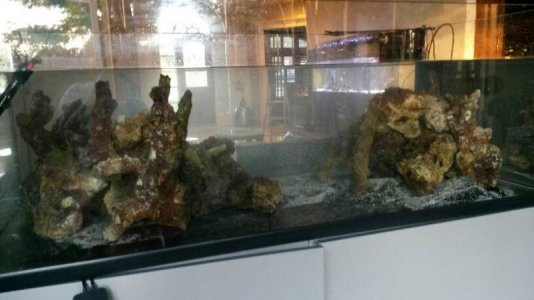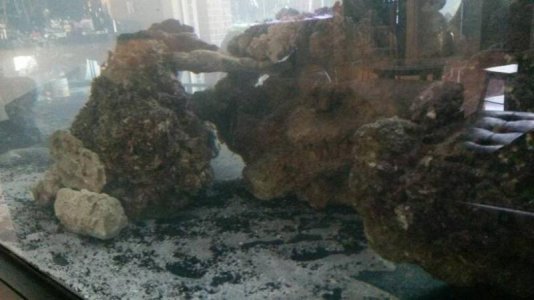Zookeepers found that 'pacing' behavior vanished from zoo cages when they filled the cage space with trees, paths, twisty ways through underbrush and plantings. Visitors stopped and watched for, say, a wild cat to emerge down a path as it would in the wild.
Your fish 'pacing' the front glass is not optimal either, for the fish's health or growth. He's only using a fraction of the tank. If, on the other hand, you create a maze of 'paths' through the rockwork, by use of caves, arches, not to forget towers/spires around which he can duck, and where, yes, food can lodge, so he can forage, you very well may get different behavior from your fish. He'll still greet you at feeding time, but he won't spend his day going up and down the glass.
Spires and pass-throughs also stop fights. They define territory. They provide landmarks for sleeping nooks, so a fish can feel secure that he has his in sight---in case of sharks. Fish don't have MUCH mind, but they do like knowing their territory, and feeling they have a 'spot' of their own.
Corals can be a part of it, of course, and can augment the maze.
And if you look at it, a maze vastly increases the territory that a fish can prowl, gives him places to look into, gives copepods and amphipods places to survive long enough to be snacks, and generally makes a comfy and variable set of pathways for fishes to travel, seeing that they use ALL the space you have for them.
Some people use plastic rods to stabilize their rockwork, and others (me included) simply stack the rock, using their natural balance and projections to lock them. You can use reef glue or superglue to stick two little rocks together into a much more useful big one. [Don't glue all your rockwork: you may need to rearrange things someday.] Reef putty can also help you form a socket to lock two disagreeable rocks together...and is easy to break apart, as are most glues, when you need to do it. As a hint on how to proceed, I recommend a few looks at Japanese gardens, which make use of horizontal elements interspersed with interesting verticals or tilted elements. Make a sketch. Translate shrubbery to rocks, and future corals, and you will have a tank that gets good healthy flowthrough (no dead spots) and much more healthily active fish, who now have places to go and holes to look into.
Note that fish behaviors differ: long-distance swimmers like some tangs (some are browsers, some are long-distance swimmers) do need a 'runway' of as much length as possible. The browsers and rock-dwellers want nooks. And browsers want a lot of places to browse in. Remember too---you have to clean that glass---so having enough room to get a cleaner-magnet into is a good thing.
You can also do a lot for your tank appearance, if you have a bow or quarter-cylinder, by keeping your side glass clean and clear: it will serve as a mirror, increasing the visible part of the tank. The fish also seem to get this mirror effect in some measure.
ROck-stacking is easy in a quarter-cylinder: a pyramid, however spread out---with towers---is your natural shape. If you have a very long tank, several independent walls or even a zigzag form may suggest itself. And having some high spots for light-loving corals as well as low is a nice thing.
Again, take a look at landscaping, especially gardens and rock gardens.
DO bury a few rocks up to their necks to serve as underground pilings that never can be moved: these prevent rockslides and shifts in the upper structure. In my own 100 gallon wedge, I have about five of these sticking up out of the sandbed, so when I 'key' an upper rock into place using one of these as my foundation, that ain't gonna budge, no matter what shoves it! I'm of the persuasion, too, that uses a foundation of eggcrate on the very bottom to prevent 'point load' from stressing the bottom glass. There are arguments for and against this, but maintaining a good crew of nassarius and (given enough room to maneuver) fighting conchs (1 per 50 gallon) can keep it pretty clean down there. Do test the stability of your structure once you've added water: the relative 'floatiness' of rocks in water may differ, and render a rockslide likely once water is added, so do give it a wiggle and be sure you're stable even before you start cycling. Likewise, put your good live rock on top of the stacks, not buried in the sand. And build your rock structure before you add sand. My own procedure is 1) eggcrate 2)basement rocks widely separated 3)intermediate rocks, 4) all sand 5) my best live rock on top of the lot.
Your fish 'pacing' the front glass is not optimal either, for the fish's health or growth. He's only using a fraction of the tank. If, on the other hand, you create a maze of 'paths' through the rockwork, by use of caves, arches, not to forget towers/spires around which he can duck, and where, yes, food can lodge, so he can forage, you very well may get different behavior from your fish. He'll still greet you at feeding time, but he won't spend his day going up and down the glass.
Spires and pass-throughs also stop fights. They define territory. They provide landmarks for sleeping nooks, so a fish can feel secure that he has his in sight---in case of sharks. Fish don't have MUCH mind, but they do like knowing their territory, and feeling they have a 'spot' of their own.
Corals can be a part of it, of course, and can augment the maze.
And if you look at it, a maze vastly increases the territory that a fish can prowl, gives him places to look into, gives copepods and amphipods places to survive long enough to be snacks, and generally makes a comfy and variable set of pathways for fishes to travel, seeing that they use ALL the space you have for them.
Some people use plastic rods to stabilize their rockwork, and others (me included) simply stack the rock, using their natural balance and projections to lock them. You can use reef glue or superglue to stick two little rocks together into a much more useful big one. [Don't glue all your rockwork: you may need to rearrange things someday.] Reef putty can also help you form a socket to lock two disagreeable rocks together...and is easy to break apart, as are most glues, when you need to do it. As a hint on how to proceed, I recommend a few looks at Japanese gardens, which make use of horizontal elements interspersed with interesting verticals or tilted elements. Make a sketch. Translate shrubbery to rocks, and future corals, and you will have a tank that gets good healthy flowthrough (no dead spots) and much more healthily active fish, who now have places to go and holes to look into.
Note that fish behaviors differ: long-distance swimmers like some tangs (some are browsers, some are long-distance swimmers) do need a 'runway' of as much length as possible. The browsers and rock-dwellers want nooks. And browsers want a lot of places to browse in. Remember too---you have to clean that glass---so having enough room to get a cleaner-magnet into is a good thing.
You can also do a lot for your tank appearance, if you have a bow or quarter-cylinder, by keeping your side glass clean and clear: it will serve as a mirror, increasing the visible part of the tank. The fish also seem to get this mirror effect in some measure.
ROck-stacking is easy in a quarter-cylinder: a pyramid, however spread out---with towers---is your natural shape. If you have a very long tank, several independent walls or even a zigzag form may suggest itself. And having some high spots for light-loving corals as well as low is a nice thing.
Again, take a look at landscaping, especially gardens and rock gardens.
DO bury a few rocks up to their necks to serve as underground pilings that never can be moved: these prevent rockslides and shifts in the upper structure. In my own 100 gallon wedge, I have about five of these sticking up out of the sandbed, so when I 'key' an upper rock into place using one of these as my foundation, that ain't gonna budge, no matter what shoves it! I'm of the persuasion, too, that uses a foundation of eggcrate on the very bottom to prevent 'point load' from stressing the bottom glass. There are arguments for and against this, but maintaining a good crew of nassarius and (given enough room to maneuver) fighting conchs (1 per 50 gallon) can keep it pretty clean down there. Do test the stability of your structure once you've added water: the relative 'floatiness' of rocks in water may differ, and render a rockslide likely once water is added, so do give it a wiggle and be sure you're stable even before you start cycling. Likewise, put your good live rock on top of the stacks, not buried in the sand. And build your rock structure before you add sand. My own procedure is 1) eggcrate 2)basement rocks widely separated 3)intermediate rocks, 4) all sand 5) my best live rock on top of the lot.
Last edited:





